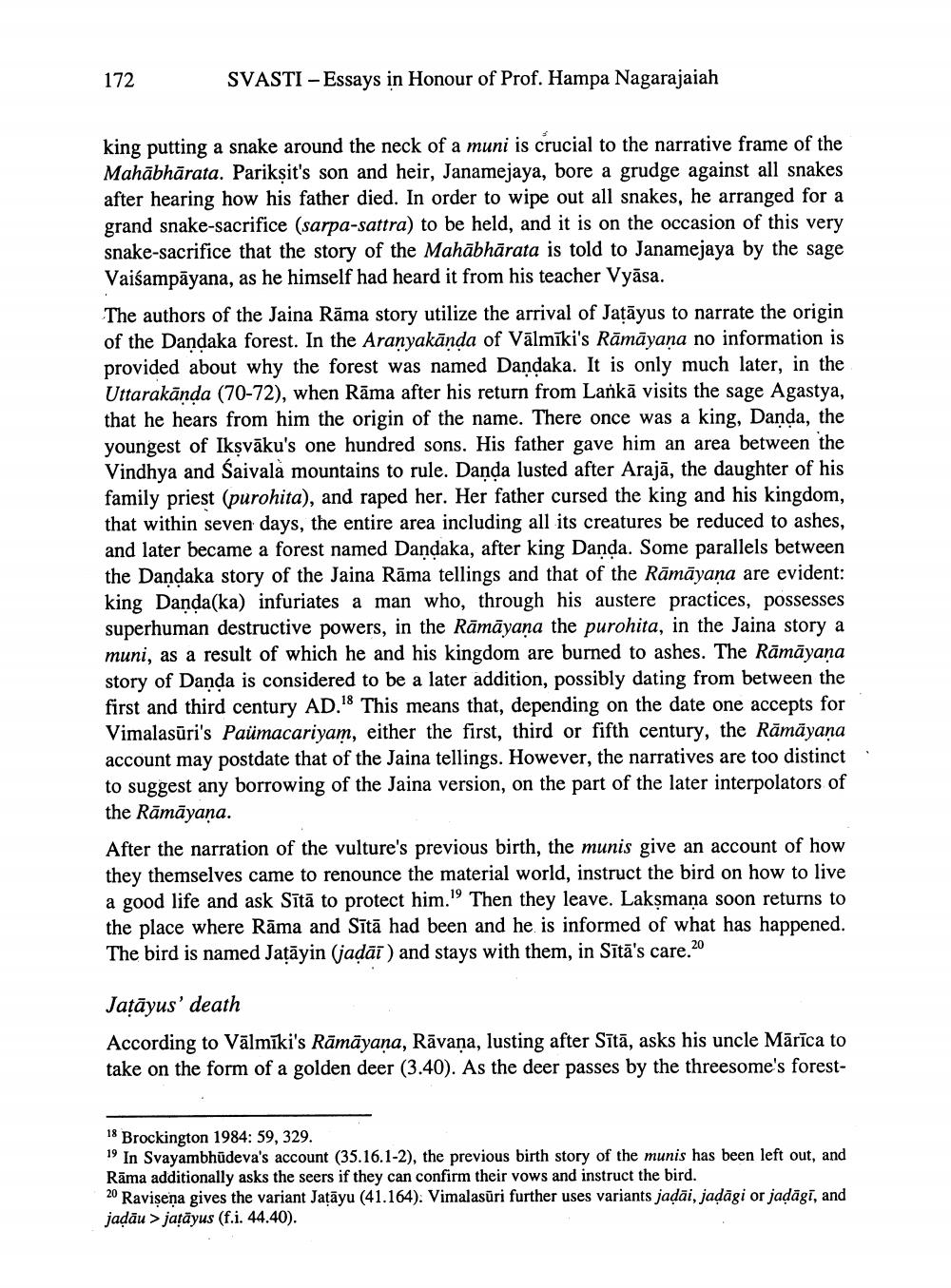________________
172
SVASTI -Essays in Honour of Prof. Hampa Nagarajaiah
king putting a snake around the neck of a muni is crucial to the narrative frame of the Mahābhārata. Parikșit's son and heir, Janamejaya, bore a grudge against all snakes after hearing how his father died. In order to wipe out all snakes, he arranged for a grand snake-sacrifice (sarpa-sattra) to be held, and it is on the occasion of this very snake-sacrifice that the story of the Mahābhārata is told to Janamejaya by the sage Vaišampāyana, as he himself had heard it from his teacher Vyāsa. The authors of the Jaina Rāma story utilize the arrival of Jatāyus to narrate the origin of the Dandaka forest. In the Aranyakānda of Vālmīki's Rāmāyana no information is provided about why the forest was named Dandaka. It is only much later, in the Uttarakānda (70-72), when Rāma after his return from Lankā visits the sage Agastya, that he hears from him the origin of the name. There once was a king, Da youngest of Iksvāku's one hundred sons. His father gave him an area between the Vindhya and Saivala mountains to rule. Danda lusted after Arajā, the daughter of his family priest (purohita), and raped her. Her father cursed the king and his kingdom, that within seven days, the entire area including all its creatures be reduced to ashes, and later became a forest named Dandaka, after king Danda. Some parallels between the Dandaka story of the Jaina Rāma tellings and that of the Rāmāyana are evident: king Danda(ka) infuriates a man who, through his austere practices, possesses superhuman destructive powers, in the Rāmāyana the purohita, in the Jaina story a muni, as a result of which he and his kingdom are burned to ashes. The Rāmāyaṇa story of Danda is considered to be a later addition, possibly dating from between the first and third century AD.18 This means that, depending on the date one accepts for Vimalasūri's Paümacariyam, either the first, third or fifth century, the Rāmāyaṇa account may postdate that of the Jaina tellings. However, the narratives are too distinct to suggest any borrowing of the Jaina version, on the part of the later interpolators of the Rāmāyana. After the narration of the vulture's previous birth, the munis give an account of how they themselves came to renounce the material world, instruct the bird on how to live a good life and ask Sītā to protect him." Then they leave. Laksmana soon returns to the place where Rāma and Sītā had been and he is informed of what has happened. The bird is named Jatāyin (jadāi ) and stays with them, in Sītā's care.20
Jatāyus' death According to Vālmīki's Rāmāyaṇa, Rāvana, lusting after Sītā, asks his uncle Mārīca to take on the form of a golden deer (3.40). As the deer passes by the threesome's forest
18 Brockington 1984: 59, 329. 19 In Svayambhūdeva's account (35.16.1-2), the previous birth story of the munis has been left out, and Rāma additionally asks the seers if they can confirm their vows and instruct the bird. 20 Ravisena gives the variant Jatāyu (41.164). Vimalasūri further uses variants jadāi, jadāgi or jadāgi, and jadau > jatäyus (f.i. 44.40).




